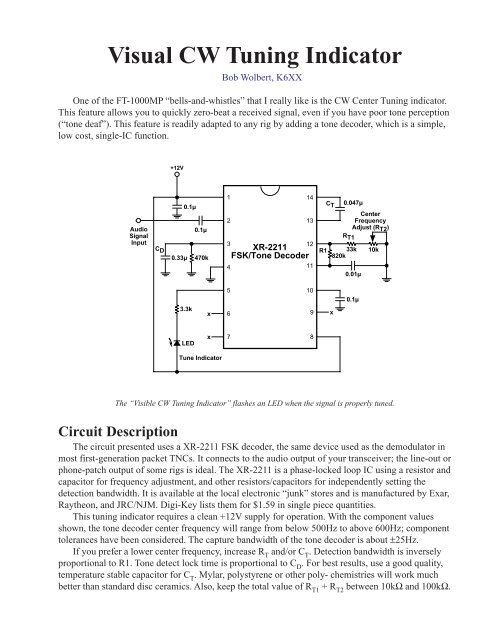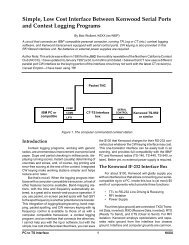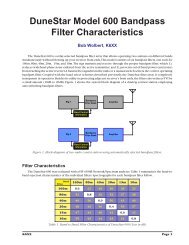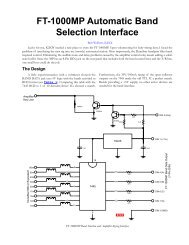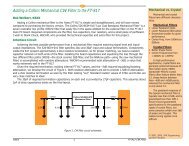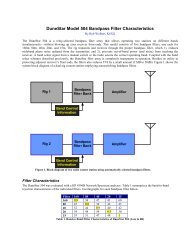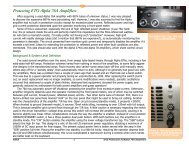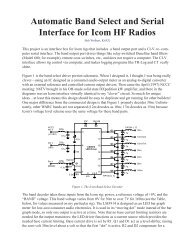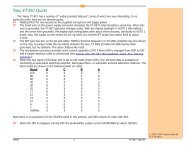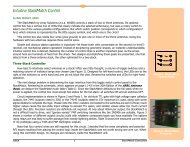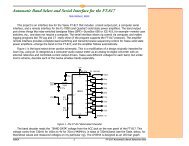Visual CW Tuning Indicator - K6xx.com
Visual CW Tuning Indicator - K6xx.com
Visual CW Tuning Indicator - K6xx.com
- No tags were found...
Create successful ePaper yourself
Turn your PDF publications into a flip-book with our unique Google optimized e-Paper software.
<strong>Visual</strong> <strong>CW</strong> <strong>Tuning</strong> <strong>Indicator</strong>Bob Wolbert, K6XXOne of the FT-1000MP “bells-and-whistles” that I really like is the <strong>CW</strong> Center <strong>Tuning</strong> indicator.This feature allows you to quickly zero-beat a received signal, even if you have poor tone perception(“tone deaf”). This feature is readily adapted to any rig by adding a tone decoder, which is a simple,low cost, single-IC function.+12VAudioSignalInputC D0.1µ0.1µ0.33µ 470k114213312XR-2211FSK/Tone Decoder411R1C T0.047µCenterFrequencyAdjust (R T2 )R T133k820k0.01µ10k3.3kx56109x0.1µLEDx78Tune <strong>Indicator</strong>The “Visible <strong>CW</strong> <strong>Tuning</strong> <strong>Indicator</strong>” flashes an LED when the signal is properly tuned.Circuit DescriptionThe circuit presented uses a XR-2211 FSK decoder, the same device used as the demodulator inmost first-generation packet TNCs. It connects to the audio output of your transceiver; the line-out orphone-patch output of some rigs is ideal. The XR-2211 is a phase-locked loop IC using a resistor andcapacitor for frequency adjustment, and other resistors/capacitors for independently setting thedetection bandwidth. It is available at the local electronic “junk” stores and is manufactured by Exar,Raytheon, and JRC/NJM. Digi-Key lists them for $1.59 in single piece quantities.This tuning indicator requires a clean +12V supply for operation. With the <strong>com</strong>ponent valuesshown, the tone decoder center frequency will range from below 500Hz to above 600Hz; <strong>com</strong>ponenttolerances have been considered. The capture bandwidth of the tone decoder is about ±25Hz.If you prefer a lower center frequency, increase R Tand/or C T. Detection bandwidth is inverselyproportional to R1. Tone detect lock time is proportional to C D. For best results, use a good quality,temperature stable capacitor for C T. Mylar, polystyrene or other poly- chemistries will work muchbetter than standard disc ceramics. Also, keep the total value of R T1+ R T2between 10kΩ and 100kΩ.
<strong>Tuning</strong> and OperationConnect the audio input to the speaker, line out, phone patch out, or similar connector on yourreceiver/transceiver. With its high input impedance, this tuning indicator does not noticeably loaddown even line-level audio outputs. Tune in a constant carrier or calibrator signal of the desired pitchand increase the audio gain higher than normal. Rotate R T2to its fully counterclockwise position,then adjust clockwise until the LED first fully illuminates. Note this shaft position. Continue turningR T2clockwise until the LED turns off. Reverse the rotation until the LED again just lights withoutflashing. Now center the shaft between the two “first light” positions. Reduce the audio gain tonormal listening levels and verify the LED remains on.After <strong>com</strong>pleting the tuning process, the LED will illuminate as you get within about 25Hz of asignal. It will flash on and off a bit with the in<strong>com</strong>ing signal: do not expect to copy code this way,however. There is a trade-off between detection speed and false triggering. The <strong>com</strong>ponent valuesshown are what I consider the best <strong>com</strong>promise. The detector takes a few dot lengths to light and,once lit, a few dot lengths to shut off (at 35 WPM or so).This circuit helps me tune in stations when searching the band. I find it especially useful when(attempting) two radio contesting. This way I can find and tune in a CQer, getting fairly close tozero-beat by watching the light, while concentrating most of my attention on the run rig.Now, I have another of the FT-1000MP features on my “old” rig at a small fraction of the price.Copyright ©1997, Bob Wolbert, K6XX


